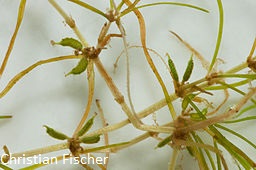
Ecological Importance
Black ducks, gadwall, mallards, northern pintails, and other waterfowl graze the fruit and foliage of Horned Pondweed. Horned Pondweed is also a fantastic food producer for trout.
Problems
Dense populations of plants reduce the water temperature and oxygen concentrations when plants die in late summer. Horned Pondweed may form dense mats blocking sunlight for other submersed vegetation along with interfering with fishing, boating and swimming.
Plant Description
Horned pondweed has long, linear, thread-like leaves. They are arranged in whorls on slender branching stems. Leaf tips taper to a point. It has tendril-like roots and slender rhizomes. The seeds are horn-shaped and form in the leaf axils.
Hints to Identify
Sago pondweed (Studkenia pectinata) and widgeon grass (Ruppia maritima) are similar in appearance to horned pondweed. Sago pondweed, however, has leaves in bushy clusters, and widgeon grass has alternate leaves, whereas horned pondweed has opposite or whorled leaves.

Common Application Questions
Q. How much should I treat?
A. Spot treat as needed to maintain navigation channels and swimming areas. Remember this plant is very beneficial and should not be treated where it is not a nuisance.
Q. When is the best time to treat?
A. Once water temperatures are around sixty degrees or warmer however this plant responds equally well to herbicide treatment when mature.
Q. How often do I need to treat Horned Pondweed?
A. One treatment per season is usually enough.
Q. How long before I see results?
A. Generally within two to three weeks things will be cleared up.
| Homeowner Treatment Options |
| Aquathol K |
| Aquathol Super K |
| Hydrothol® Granular |
| Sonar AS |
| Sonar RTU |
| *Aquatic Biologists recommends implementing preventative management techniques and physical removal prior to, or in conjunction with treatment. |
